Draft Desert-Weeds Introduction
Abstract
Weeds are the first stage of recovery following disturbances that reduce the cover of perennial plants and biological soil crusts (BSCs). This normal weed function can change when people transport weeds to habitats outside their home range. Freed from their usual consumers and competitors, some of the transported weeds invade the new habitats and replace local plants. Diversity, productivity, and stability decline. As their abundance increases, the invaders’ dried remains often provide fine fuel that increases ignition and spread of lightning and human caused fires. In some regions, desert fire frequency has increased beyond the recovery ability of native vegetation and BSCs. This creates new plant communities dominated by weeds sometimes with a few of the smaller, faster-growing members of the original plant community. Control of invasive weeds requires public participation, inventories, habitat protection, monitoring systems, prioritization of species and sites, and strong financial support.
Weeds Characteristics
Plants with strong dispersal mechanisms, tolerance of the drying effect of full sunlight, and capacity for rapid growth can colonize disturbed sites and grow free of interference by plants from the pre-disturbance vegetation.
While some plants live long deliberate lives of hundreds or thousands of years, natural disturbances opened an alternate evolutionary pathway for the weeds. Except for the spreading roots of a few species and some short-lived trees, most weeds live only one or two years. Even among those with long-lived roots, the parts we see, the shoots, are short-lived.
Weeds’ short lives and their preference for full sun does not allow them to compete with large, mat-forming, shade-casting, long-lived climax species of the desert grasslands, shrublands, woodlands, and forests. During the normal course of events, those species spread back into disturbed sites and replace the weeds. The long-lived plants persist until another catastrophe exposes the soil and allows the weeds to return.
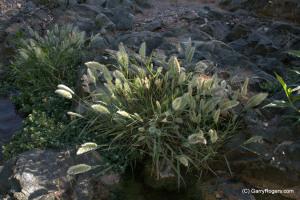
Figure 1. Rabbitfootgrass (Polypogon monspeliensis). This moisture-loving grass probably originated in Europe, but it became a global cosmopolitan so early in human history its origin is uncertain. This one is growing beside the Agua Fria River, a small desert stream in central Arizona. Rabbitfootgrass can spread through dry upland sites by following roadside ditches where it joins a diverse collection of invasive species.
In deserts, drought-tolerant weeds spread across upland slopes, and moisture-dependent invaders spread along the banks of streams and springs. However, weeds are the supreme opportunists, and many can reproduce at a broad range of sizes. When moisture is limited, summer cypress (Kochia scoparia) for example, can mature and produce a single spike of seeds at a height of three centimeters. When enough moisture is available, summer cypress can reach four meters in height and produce many seed laden spikes. Moreover, weeds that colonize stream banks can spread to upland habitats following periods of above average rainfall. They may seem to disappear when average conditions return, but many leave behind persistent propagules ready to continue advancing in future wet periods.
In most instances, weed establishment requires disturbed habitats. Some invasive weeds might be capable of invading undisturbed natural vegetation, but determining this is difficult. Livestock grazing, food and fuel gathering, and farming have damaged ecosystems across the desert biome.
In their rapid response to vegetation destruction by construction, fires, floods, and foraging animals, weeds resemble human first responders. Weeds cover exposed soil and give protection from erosion. Following geomorphic events such as landslides, weed roots and decaying parts bind sand and gravel and rebuild the soil.
However, when people disperse weeds beyond their normal range, problems can develop. Freed from home range predators and competitors, a few introduced weeds will invade undisturbed or lightly disturbed local habitats and can sometimes replace climax plants.
Natural floods, storms, lightning-caused fires, and geological events create disturbed conditions that weeds evolved to fill. Human activities, construction, farming, domestic livestock grazing, human-caused fires, and climate-change enhanced weather events and droughts, create abundant opportunities for weeds to spread.
Dispersal
Animals, wind, water, and people walking, boating and driving serve as weed dispersal vectors. R. Frenkel (1970) once analyzed the debris traps of the drains at a car wash and found the propagules of over 400 species. Most weed propagules spread adhered to surfaces, moving through guts, or mixed with seeds of agricultural crops. However, people have planted many weeds to provide soil stabilization, to produce food for livestock and people, to serve as garden ornamentals, and more. On many well-documented occasions, introduced species have spread beyond their intended
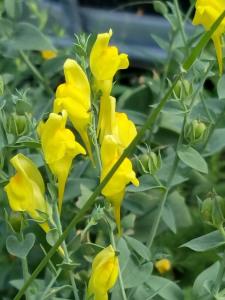
Figure 2. Dalmatian toadflax (Linaria dalmatica), a common horticultural flower, spreads by seeds and long-lived underground roots.
purpose, invading native vegetation with disastrous effects. For example, nurseries sell dalmatian toadflax (Linaria dalmatica) for flower gardens. Toadflax roots delve deep, persist for years, and may send up shoots outside flowerbeds. Controlling Toadflax is not difficult in small gardens and yards, but seeds often spread into native vegetation. Once established, the plants’ deep root systems have allowed it to become a permanent resident across thousands of hectares of arid shrublands and woodlands.
Weed dispersal vectors deposit propagules along roads and fences, beneath the distal tips of tree and shrub branches, and on the margins of irrigated pastures and crops. In addition to seeds, weed propagules include underground rhizomes, surface stolons, and vines. These organs can grow 10 meters or more per year, but none of them attains the velocity achieved by the seeds of weeds whose seedpods explode when they become dry. These botanical cannoneers propel their seeds surprising distances. The bursting seedpods of creeping woodsorrel (Oxalis corniculata), a petite weed of stream banks and field margins, can shoot seeds more than three meters.
Most introduced weeds do not spread or even survive to form a persistent population. Some grow scattered among other plants and have limited impact. A few will remain in small patches for years and then begin to spread. However, less than 10% of the hundreds of alien weed species people passively or intentionally introduce to the deserts will invade and replace native vegetation.
Fire
Fire was not important in deserts before invasive weeds arrived. Unlike plants of the temperate grasslands and semiarid evergreen woodlands and forests, the often widely spaced deserts plants are too discontinuous for fires to spread. In fact, Rogers and Steele (1980) found almost no fire-tolerant traits among the dominant shrubs and trees of the Sonoran Desert. Introduced weeds that spread in the Great Basin Desert in the Nineteenth Century (Watson 1871) provided a new source of fine fuel that facilitated ignition and spread of fires. These weeds became the most disruptive invasive species on Earth (Brooks, D’Antonio, Richardson, et al. 2004). The introduced weeds that were more efficient than natives were at extracting moisture and nutrients from desert soils invaded the desert vegetation, filled the gaps between perennial plants, and gave fires continuous fuel in which to spread. Over the past century, desert fires have decimated millions of hectares of native vegetation.
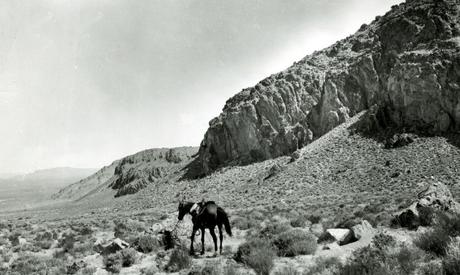
Figure 3. This photograph taken by G. K. Gilbert in1901 illustrates typical salt desert shrubland dominated by Shadscale (Atriplex confertifolia) at lower elevations of the Great Basin Desert. Photograph © U. S. Geological Survey Photograph Library.
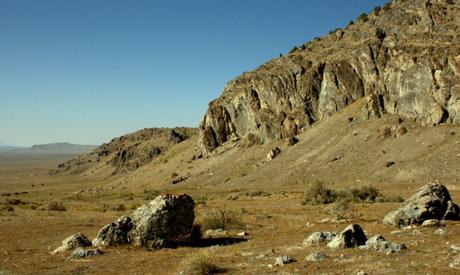
Figure 4. Matching the photograph in Figure 3, this photograph taken by G. Rogers September 1, 2008 shows that most of the shrubs are gone. A dry thatch of cheatgrass (Bromus tectorum) and redstem filaree (Erodium cicutarium) covers the ground. Photograph © Garry Rogers.
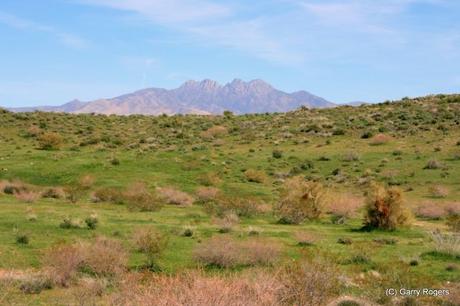
Figure 5. Photograph taken by G. Rogers February 29, 2008. Two fires (1974 and 1987) transformed the saguaro-paloverde (Carnegiea gigantea-Parkinsonia microphylla) woodland of this Sonoran Desert site to a triangle bursage-brittlebush (Ambrosia deltoidea-Encelia farinosa) shrubland. Before the 1974 fire, tall saguaro and rounded paloverde and ironwood in a matrix of shrubs covered and crowned the slopes and ridges. The small shrubs in the foreground of the 2008 photograph are triangle bursage, and brittlebush. They occur in a matrix of small weeds consisting mainly of redstem filaree (Erodium cicutarium). Later in the growing season, this site may be dominated by red brome grass (Bromus rubens). The teddy bear cholla (Cylindropuntia bigelovii) in the center of the scene is the sole survivor of a once extensive stand of thorny cactus that protected nesting dove and covered the ground, defending this ridge from erosion and invasive plants. Photograph © Garry Rogers.
Biological Soil Crusts
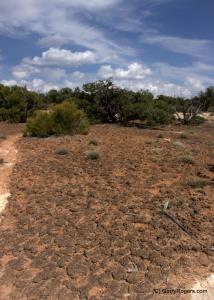
Figure 6. Pinnacled biological soil crust in a protected area of the Great Basin Desert. Such crusts trap moisture and nutrients and block invasive weeds. Livestock trampling can eliminate them. Photograph © Garry Rogers.
Two groups of microorganisms are important constituents of desert ecosystems. Biological soil crusts (BSCs) composed of soil particles, cyanobacteria, algae, microfungi, lichens, and bryophytes form thin layers on exposed soil surfaces between desert plants. BSCs cover and stabilize the soil, capture nutrients, and retain moisture. They make up over 70 % of the living ground cover in parts of the deserts. BSCs develop best with full sun exposure, and their cover increases as annual precipitation and vascular plant cover decrease.
Arbuscular mycorrhizal fungi (AMF) sheath and connect the roots of desert plants. AMF are obligate symbionts whose carbon nutrition depends on the photosynthetic success of their host plant. They benefit hosts by facilitating absorption of water, phosphorus and other micronutrients, and they can increase nodule formation by nitrogen-fixing bacteria.
Well-developed BSCs and AMF help prevent entry by invasive weeds. BSCs limit germination sites and AMF increase the success of native plants and inhibit the growth of invasives (Vogelsang and Bever 2009). Wheeled vehicles, livestock trampling, and fire can destroy BSC and AMF continuity. Like vascular plants (Rogers and Steele 1980), BSCs, and AMF can take decades to recover (Root, Brinda, and Dodson 2017).
Invasive Weed Management
Early detection of new weeds is critical. In just a few years, invaders can form large colonies with many distant satellite populations. Managers prepare treatment plans for invaders, establish schedules for repeated surveys, and enlist public assistance in finding and treating invaders. Rapid response measures must be ready to control or eradicate detected invaders before they can spread. Detailed information for weed management is available online from the North American Invasive Species Management Association. The Center for Agriculture and Biosciences International provides news and national weed control plans and policies indexed by subject and by location.
Strategic Concepts
Adaptive Management
Weed managers view every weed control treatment as experimental. They define the methods and study the results of each treatment to gain insights that will allow shifting tactics to get improved results.
Justification for Invasive Weed Management
The field of Weed Science developed in response to the loss of crop yields because of weed invasions. Learning to measure the economic cost of wildland invasions has taken longer but is now well developed (Farber, Costanza, and Childers, et al. 2006). De Groot, Brander, Van Der Ploeg, et al. (2012) provide estimates of the monetary value of ecosystems and their services across global biomes, and Naylor (2000) discusses the reduction of ecosystem services by invasive species.
Prevention, Regulation, and Ecosystem Maintenance
Weed management involves defense and target hardening. Defense requires policies and regulations to stop weed imports by people, livestock, and equipment. Target hardening promotes landuse policies that maintain healthy native vegetation. Many regions have agricultural inspection regulations in place to prevent entry of plants and diseases that invade farms and natural vegetation. Likewise, weed managers promote public education and sustainable grazing and other native plant harvests. For example, the Play, Clean, Go program publicizes the invasive species problem and enlists citizen participation in weed management.
Early Detection, Monitoring and Response
Effective weed control requires rapid detection and response. The goal is to prevent maturation and seed production by potential invaders. It requires preliminary inventories and regular monitoring to discover new populations before they can spread. Because of the uncertain survival of new weeds, the first response to most species is establishing a monitoring schedule. This does not apply to weed species known to be invasive in similar sites.
Satellite Populations
Weed populations grow by expanding their boundary and by long-distance dispersal to establish outlying or satellite populations. Since a single plant can produce thousands of seeds, tiny satellite populations of one or a few plants can serve as significant sources for further invasion. As the area of an infestation grows, the proportion of each plant’s propagules falling among the plants within the occupied area will increase and the proportion falling outside the area will decline. Thus, the rate of expansion will decrease as the infested area grows. Because the rate of expansion is greater for small satellite populations, managers treat satellite populations of known invaders first.
Coordination with Neighbors
Property boundaries do little to influence weed dispersal and establishment. Fences may stop the first wave of tumbleweeds, and they may create rows of bird-dispersed weeds, but they are not an effective barrier. Coordinating prevention, inventory, and control with neighboring agencies and private landowners is part of weed management planning.
Control vs. Eradication
Immediate eradication is sometimes the most cost effective option. Annual costs to control weeds increases as new species arrive and existing species establish satellite populations. Even though eradication of a widespread species is difficult and costly, it might be essential to protect native ecosystems. Mack and Foster (2009) found that eradication of a widespread species requires most of the following conditions.
- An effective prevention plan is in place.
- An exhaustive inventory is available.
- The target species are easy to find. Failure to find all individuals creates opportunities for new seed banks to form.
- Terrain is accessible and easily inventoried and monitored.
- Target species’ seed bank is short lived (only 3 years).
- Target species’ current range is small enough that available resources are adequate for inventory, eradication, and monitoring.
- Concurrent treatment of satellite and source populations is possible.
- Monitoring will continue well past the expected duration of the seed bank. Otherwise, seedlings and other individuals missed in inventories, treatments, and subsequent monitoring will produce new seed banks.
- Public and financial support is constant.
Inventory
Inventories to discover and map invasive species rely on two approaches. The first is for areas of continuous weed cover. It produces vegetation maps made from sample observations (Mueller-Dombois and Ellenberg, H., 1974). The second method is for areas of scattered weed presence. It creates descriptions and small maps of weed occurrence. Continuous weed cover develops as repeated fires, floods, or overgrazing weaken and remove native vegetation. Scattered weed presence occurs around trees, along fences, and in patches of disturbed vegetation. Since some weed species become invasive after years of quite residence, initial inventory maps and descriptions should include all known weed species. Managers can treat known invaders immediately and set monitoring schedules for other weeds.
Prioritizing Weed Species and Sites in Deserts
Prioritizing Species
Prioritization equips weed managers for immediate response when known invaders appear. Locating information on the ecology, distribution, and control of weeds requires literature searches for each species. The information produced by the searches is variable and may not cover local conditions. However, it provides a first approximation of the relevant characteristics and control treatments for species that are present. Critical considerations for prioritizing species include potential for arrival, establishment, spread, and impact. Large data sets are available from the Global Register of Introduced and Invasive Species and the Invasive Species Compendium hosted by the Center for Agriculture and Biosciences International. Internet links for these and other Internet information sources follow the references.
The ideal prioritization system integrates ecological knowledge of individual species with site conditions, and adjusts with observed results of treatments.
Prioritizing Sites

Figure 7. Damaged streambank. Water diversions, livestock, human travel and settlement, and floods disturb desert riparian habitats. The site in this photograph retains high value despite the impacts because it is a perennial stream with a relatively large willow-cottonwood riparian forest occupying the floodplain. Photograph © Garry Rogers.
Hobbs and Humphries (1995) proposed ranking sites for weed control based on two factors, resource value and level of site disturbance. Protected parks, wilderness areas, and critical habitats such as desert streams have more ecosystem value and should receive greater weed-control effort than highly disturbed upland areas. The diagram below illustrates weed management responses for sites and species of varying priority.
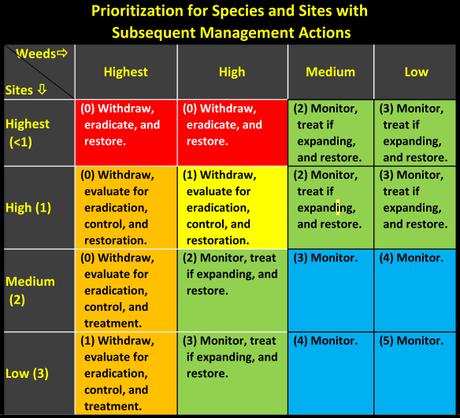
Figure 8. Priority sites and species. Numbers in the left column show the minimum search frequency in years to detect new infestations. Highest-priority sites receive two or more visits each year because some species germinate throughout the growing season and others germinate during spring or summer.
Numbers in cells (not including the left column) indicate the recommended frequency in years for monitoring existing infestations. The “0” in the cells for highest and high priority sites and the weed designations “Highest” and “High” show rapid response instead of monitoring. The seasonal timing of observations should follow maturation of the weeds. For weeds that germinate throughout the growing season, this would be autumn. The term “withdraw” indicates intervention to limit human disturbances. Monitor sites in the cells at lower right to detect appearances by high-priority species. Depending on resources and proximity to high-value sites, managers might eradicate such species. Image © Garry Rogers.
Treatment
Treatment tactics vary for each weed species and each site. They include pulling and mowing, chemical herbicides, releases of predatory insects and microorganisms imported from homelands, planting native species, prescribed fires, and combinations of these. Published information on individual weed responses to some treatments is often available, but for many weeds, results of treatments are unpredictable.
Restoration
Healthy native vegetation resists weed invasions. However, eradicating invasive weeds and preventing their return while aiding establishment of native species is difficult and expensive. Weeds often leave behind persistent propagules, changed soil chemistry, and depleted soil microorganism communities. Restoration costs are justified only for the highest priority sites. The Society for Ecological Restoration supplies information with examples and techniques on the organization’s website.
Explaining Invasions
Eurasia has produced most of the invasive weeds found on other continents. The larger Eurasian deserts, with their broad connection to North Africa, their great environmental variability, and their long history of Old World human occupation and disturbance created pressures for Eurasian weeds to evolve better dispersal, establishment, growth, and reproduction abilities than the weeds of Africa, Australia, and the New World. No North American weeds can match the overwhelming success of cheatgrass, redstem filaree (Erodium cicutarium), and others that have spread across the arid western U. S.
Weeds grow and spread in new habitats because they are free of their homeland predators and competitors. Casual and formal tests of this ‘escape hypothesis’ have had mixed results, but most support the idea. For example, Lucero (2018) found granivorous rodents preferred seeds of native brome grass and left more seeds of the invaders to spread and germinate.
Predators, competitors, and environmental conditions restrain most introduced weeds. Those that spread after a period of stasis might do so because they have made genetic adaptations to the new conditions.
The most successful desert invaders are those that mature and dry by late spring or early summer and produce fire-tolerant seeds. As mentioned above, these fireweeds are spreading, and fueling destructive desert fires that are wiping out native shrubs and trees (Figures five and six).
The Future
Disturbances of native vegetation and introductions of new weeds are increasing. As climate change intensifies droughts and storms, disturbances will multiply. The traits of invasive weeds that allow them colonize new sites–their short lives, high mobility, rapid reproduction, and genetic adaptability—also equip them for success with shifting weather and climate. Without increased control efforts, a legacy of the Anthropocene will be weed dominance of the desert biome.
References
Brooks, M. L., D’Antonio, C. M., Richardson, D. M., et al. (2004). Effects of invasive alien plants on fire regimes. BioScience 54, 766-788.
De Groot, R., Brander, L., Van Der Ploeg, S., et al. (2012). Global estimates of the value of ecosystems and their services in monetary units. Ecosystem Services, 1, 50-61.
Farber, S., Costanza, R., Childers, D. L., et al. (2006). Linking ecology and economics for ecosystem management. Bioscience 56, 121-133.
Frenkel, R. E. (1970). Ruderal vegetation along some California roadsides. University of California Publications in Geography (Volume 20). Berkeley, CA: University of California Press.
Hobbs, R. J., and Humphries, S. E. (1995). An integrated approach to the ecology and management of plant invasions. Conservation Biology 9, 761-770.
Lucero, J. E. (2018). Do seeds from invasive bromes experience less granivory than seeds from native congeners in the Great Basin Desert? Plant Ecology 219, 1053-1061.
Mack, R. N., and Foster, S. K. (2009). Eradicating plant invaders: Combining ecologically-based tactics and broad-sense strategy. In Inderjit, (ed.) Management of invasive weeds, pp 35-60. Dordrecht: Springer.
Mueller-Dombois, D., and Ellenberg, H. (1974). Aims and methods of vegetation ecology. New York: John Wiley and Sons.
Naylor, R. L. (2000). The economics of alien species invasions. In Mooney, H. A. & Hobbs, R. J. (eds.) Invasive species in a changing world, pp 241-259. Washington, D. C.: Island Press.
Rogers, G. F., and Steele, J. (1980). Sonoran desert fire ecology: Adaptive strategies of perennial plant species. In: Stokes, M. A., and Dieterich, J. H. (tech. coords.) Proceedings of the Fire History Workshop, pp. 15-19. Tucson, Arizona: U.S. Forest Service, General Technical Report RM‑81:15‑19.
Root, H. T., Brinda, J. C., and Dodson, E. K. (2017). Recovery of biological soil crust richness and cover 12-16 years after wildfires in Idaho, USA. Biogeosciences 14, 3957-3969.
Vogelsang, K. M., and Bever, J. D. (2009). Mycorrhizal densities decline in association with nonnative plants and contribute to plant invasion. Ecology 90, 399-407.
Watson, S. 1871. Botany. In King, C. Report of the geological exploration of the fortieth parallel. Professional Papers of the Engineer Department, U. S. Army 18: i-Liii, 1-525.
List of Relevant Websites
Center for Agriculture and Biosciences International, Invasive Species Compendium (https://www.cabi.org).
Global Register of Introduced and Invasive Species (http://www.griis.org). Lists species and sources of information for 196 countries.
Heap, I. (2018).The International Survey of Herbicide Resistant Weeds www.weedscience.com.
North American Invasive Species Management Association (http://www.naisma.org).
Play, Clean, Go—Stop invasive species in your tracks (http://www.playcleango.org).
Society for Ecological Restoration (https://www.ser.org).
- S. National Invasive Species Information Center (https://www.invasivespeciesinfo.gov).
Weed Science Society of America (http://wssa.net). Publishes: Invasive Plant Science and Management, Weed Science, and Weed Technology.

